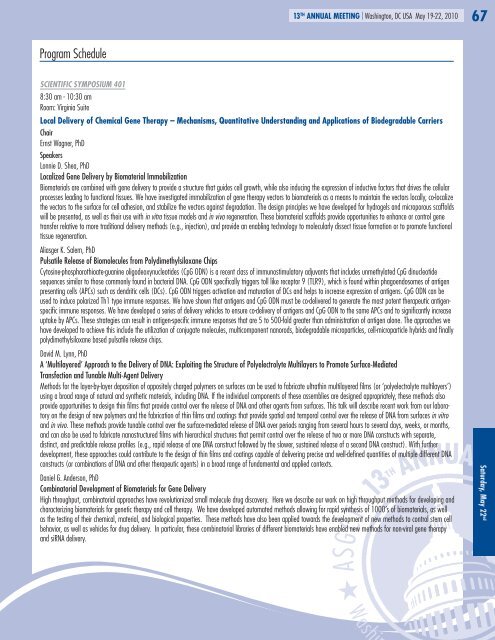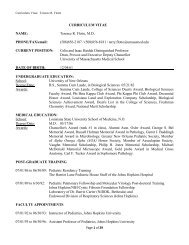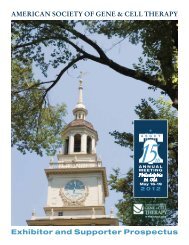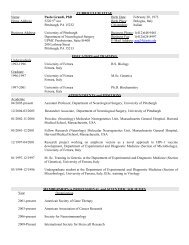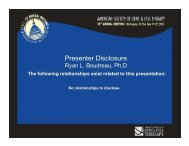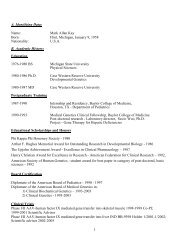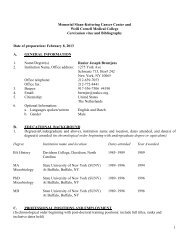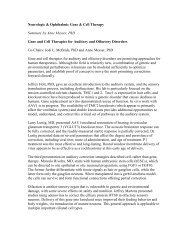FINAL PROGRAM - American Society of Gene & Cell Therapy
FINAL PROGRAM - American Society of Gene & Cell Therapy
FINAL PROGRAM - American Society of Gene & Cell Therapy
- No tags were found...
You also want an ePaper? Increase the reach of your titles
YUMPU automatically turns print PDFs into web optimized ePapers that Google loves.
13 th AnnUAL MEETing | Washington, DC USA May 19-22, 2010 67Program ScheduleScientific Symposium 4018:30 am - 10:30 amRoom: Virginia SuiteLocal Delivery <strong>of</strong> Chemical <strong>Gene</strong> <strong>Therapy</strong> – Mechanisms, Quantitative Understanding and Applications <strong>of</strong> Biodegradable CarriersChairErnst Wagner, PhDSpeakersLonnie D. Shea, PhDLocalized <strong>Gene</strong> Delivery by Biomaterial ImmobilizationBiomaterials are combined with gene delivery to provide a structure that guides cell growth, while also inducing the expression <strong>of</strong> inductive factors that drives the cellularprocesses leading to functional tissues. We have investigated immobilization <strong>of</strong> gene therapy vectors to biomaterials as a means to maintain the vectors locally, co-localizethe vectors to the surface for cell adhesion, and stabilize the vectors against degradation. The design principles we have developed for hydrogels and microporous scaffoldswill be presented, as well as their use with in vitro tissue models and in vivo regeneration. These biomaterial scaffolds provide opportunities to enhance or control genetransfer relative to more traditional delivery methods (e.g., injection), and provide an enabling technology to molecularly dissect tissue formation or to promote functionaltissue regeneration.Aliasger K. Salem, PhDPulsatile Release <strong>of</strong> Biomolecules from Polydimethylsiloxane ChipsCytosine-phosphorothioate-guanine oligodeoxynucleotides (CpG ODN) is a recent class <strong>of</strong> immunostimulatory adjuvants that includes unmethylated CpG dinucleotidesequences similar to those commonly found in bacterial DNA. CpG ODN specifically triggers toll like receptor 9 (TLR9), which is found within phagoendosomes <strong>of</strong> antigenpresenting cells (APCs) such as dendritic cells (DCs). CpG ODN triggers activation and maturation <strong>of</strong> DCs and helps to increase expression <strong>of</strong> antigens. CpG ODN can beused to induce polarized Th1 type immune responses. We have shown that antigens and CpG ODN must be co-delivered to generate the most potent therapeutic antigenspecificimmune responses. We have developed a series <strong>of</strong> delivery vehicles to ensure co-delivery <strong>of</strong> antigens and CpG ODN to the same APCs and to significantly increaseuptake by APCs. These strategies can result in antigen-specific immune responses that are 5 to 500-fold greater than administration <strong>of</strong> antigen alone. The approaches wehave developed to achieve this include the utilization <strong>of</strong> conjugate molecules, multicomponent nanorods, biodegradable microparticles, cell-microparticle hybrids and finallypolydimethylsiloxane based pulsatile release chips.David M. Lynn, PhDA ‘Multilayered’ Approach to the Delivery <strong>of</strong> DNA: Exploiting the Structure <strong>of</strong> Polyelectrolyte Multilayers to Promote Surface-MediatedTransfection and Tunable Multi-Agent DeliveryMethods for the layer-by-layer deposition <strong>of</strong> oppositely charged polymers on surfaces can be used to fabricate ultrathin multilayered films (or ‘polyelectrolyte multilayers’)using a broad range <strong>of</strong> natural and synthetic materials, including DNA. If the individual components <strong>of</strong> these assemblies are designed appropriately, these methods alsoprovide opportunities to design thin films that provide control over the release <strong>of</strong> DNA and other agents from surfaces. This talk will describe recent work from our laboratoryon the design <strong>of</strong> new polymers and the fabrication <strong>of</strong> thin films and coatings that provide spatial and temporal control over the release <strong>of</strong> DNA from surfaces in vitroand in vivo. These methods provide tunable control over the surface-mediated release <strong>of</strong> DNA over periods ranging from several hours to several days, weeks, or months,and can also be used to fabricate nanostructured films with hierarchical structures that permit control over the release <strong>of</strong> two or more DNA constructs with separate,distinct, and predictable release pr<strong>of</strong>iles (e.g., rapid release <strong>of</strong> one DNA construct followed by the slower, sustained release <strong>of</strong> a second DNA construct). With furtherdevelopment, these approaches could contribute to the design <strong>of</strong> thin films and coatings capable <strong>of</strong> delivering precise and well-defined quantities <strong>of</strong> multiple different DNAconstructs (or combinations <strong>of</strong> DNA and other therapeutic agents) in a broad range <strong>of</strong> fundamental and applied contexts.Daniel G. Anderson, PhDCombinatorial Development <strong>of</strong> Biomaterials for <strong>Gene</strong> DeliveryHigh throughput, combinatorial approaches have revolutionized small molecule drug discovery. Here we describe our work on high throughput methods for developing andcharacterizing biomaterials for genetic therapy and cell therapy. We have developed automated methods allowing for rapid synthesis <strong>of</strong> 1000’s <strong>of</strong> biomaterials, as wellas the testing <strong>of</strong> their chemical, material, and biological properties. These methods have also been applied towards the development <strong>of</strong> new methods to control stem cellbehavior, as well as vehicles for drug delivery. In particular, these combinatorial libraries <strong>of</strong> different biomaterials have enabled new methods for non-viral gene therapyand siRNA delivery.Saturday, May 22 nd


